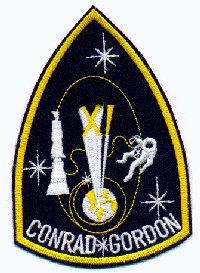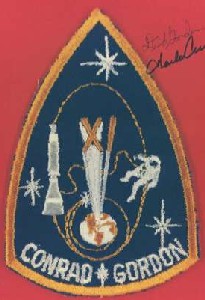
September 12 - 15, 1966

Crew & Mission
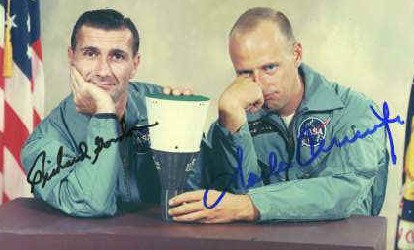 Astronauts Charles Conrad, Jr. and Richard F. gordon, Jr. the prime crewmmbers for the Gemini-XI mission were selected on March 21, 1966 together with the back-up crew: Neil Armstrong and Bill Anders.
Astronauts Charles Conrad, Jr. and Richard F. gordon, Jr. the prime crewmmbers for the Gemini-XI mission were selected on March 21, 1966 together with the back-up crew: Neil Armstrong and Bill Anders.
Gemini-XI was launched on September 12, 1966 at 09:42:26.5 am. One and a half hour earlier a Atlas-Agena target vehicle was launched at 08:05:02 am. Gemini-XI had an ambitious flight plan and most of the mission objectives were achieved. One of the most important accomplishments of the flight was the succesful rendezvous and docking with the Agena target vehicle during the spacecraft's first revolution.
Astronaut Dick Gordon completed fastening a tether to the spacecraft's docking bar during his umbilical EVA at the expense of a great amount of energy and the crew decided to terminate that activity because of pilot fatigue. The hatch was open for 33 minutes.
Shortly after the third day of the flight was started, the Gemini-XI crew racked up another first. They undocked from the Agena and started a successful tethered operation. The two spacecraft made about two revolutions around the earth while fastened together.
Another important first - the automatic reentry - was attempted for the first time in the Gemini program. Retrofire occurred over the Canton Island tracking station at 70 hours, 41 minutes, and 36 seconds MET. The splash down was about 35 minutes later, approximately one-and-a-half miles from the prime recovery ship, the USS Guam. Conrad and Gordon were taken to the USS Guam by helicopter 24 minutes after they landed, and the spacecraft was retrieved 59 minutes after landing.
A Personal Story
"Pete Conrad was able to convince NASA to let us take our Gemini spacecraft up to a new orbital record. Our Gemini XI patch depicts the various elements of our mission. The first orbit rendezvous (M equals 1) is marked by a star, so is our docking with the Agena target vehicle, our high orbit of 850 miles and my spacewalk. The Roman numerals XI are shown raising off the Earth as another indication of our new altitude record. We had the shortest launch window in the Gemini program. (Richard R. Corley of the Gemini Program Office first suggested trying a first orbit rendezvous). Our window was just 2 seconds long and we only used a 1/2 second of it on launch. On reentry we let the computer fly us on in for the first time. All the previous flights had been flown in from about 72 miles altitude by the Commanders. This pinpoint accuracy was necrssary for our future Moon missions. The patch also shows the docked Gemini-Agena combination and my tethered spacewalk. Our Gemini-Agena tethered experiment produced an artificial gravity of two bodies orbiting together. Both Pete and I are Navy men and used blue and gold for our patch since they are the Navy's colors."
The Artwork
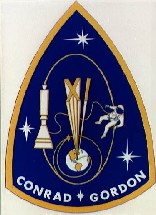
The Gemini-11 mission has an ambitous flight plan wich included rendezvous, docking, flight at a high altitude and EVA. All these objectives were included on the mission patch wich took the form of a Gemini capsule (although not very accurately). The four main stars on the patch represent the four main objectives. The roman numeral XI shown rising off the earth is another indication of the high altidude flown on this mission.
A pictorial representation of the docked Gemini-Agena and an astronaut performing an EVA (Gordon) are also present. The names of both crew members (Conrad and Gordon) are located at bottom left and right and are separated by a single star. Some souvenier patches do not include this star although it was certanly present on the flight patches. The fact that both crew members were from the US Navy influenced the colours used on the patch (blue and gold). The crew wore their patches on the right sleeves of their spacesuits.
Spot the Patch

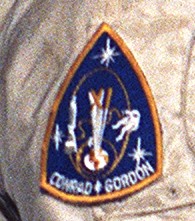
Souvenir
